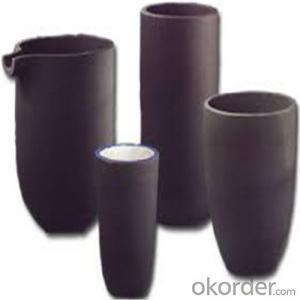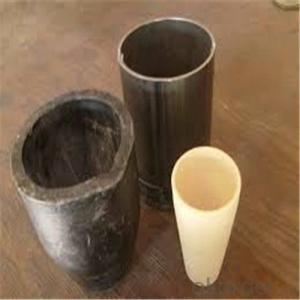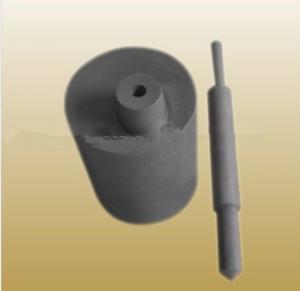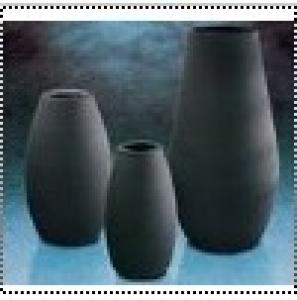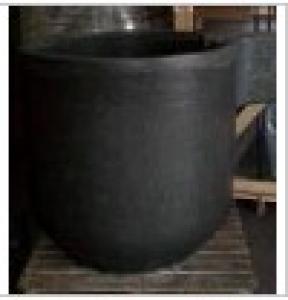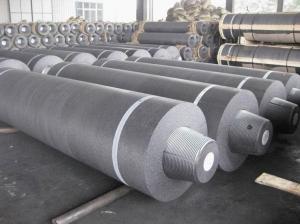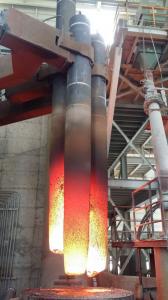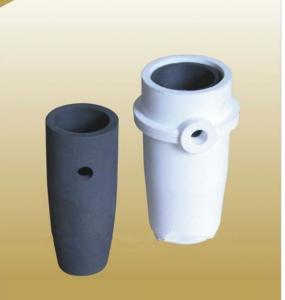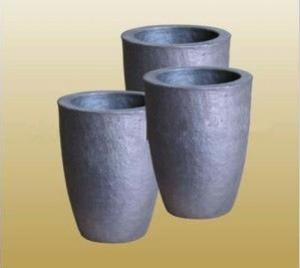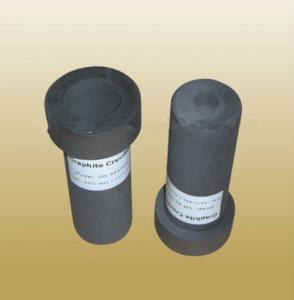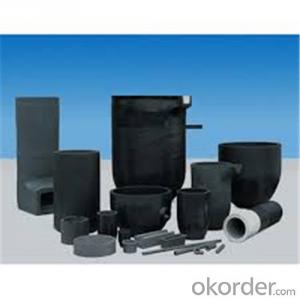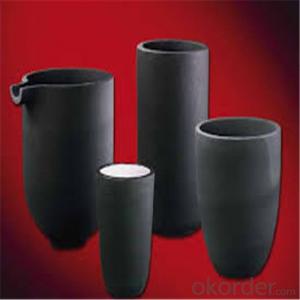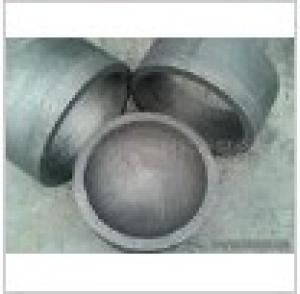SiC Crucibles For Melting Aluminium And Copper, Brass, SIC Graphite Crucible
- Loading Port:
- Shanghai
- Payment Terms:
- TT OR LC
- Min Order Qty:
- 1 pc
- Supply Capability:
- 1000 pc/month
OKorder Service Pledge
OKorder Financial Service
You Might Also Like
Quick Details for SiC Graphite Crucibles
| Type: | High Strength, graphite crucible crucible | Application: | melting metal | Height: | as your requirements |
| Composition: | High Pure | Top Diameter: | 10-600mm | Bottom Diameter: | 10-1000mm |
| Place of Origin: | China (Mainland) | Brand Name: | Model Number: | ||
| Color: | Black grey | Si3N4%: | 5min | Fe2O3%: | 0.7max |
| C%: | 30-45 | Apparent porosity: | 30max | Refractoriness: | 1680 |
| Bulk Density: | 1.71min | Using life: | >5000 hours | MAX temperature: | 1600c |
Packaging & Delivery
| Packaging Details: | Seaworty packing or as per customer's detail requirement of graphite crucible. |
| Delivery Detail: | within 20-30 days after confirm order of graphite cru |
SiC Graphite Crucibles For Melting Aluminium And Copper, Brass
Product Description
Specifications for Graphite Silicon Carbide Crucible For Aluminum Melting :
1.Long working lifetime: its working lifetime is increased 3-5 times over normal clay-crucible due to the compact body formed under high pressure.
2.High thermal conductivity: high-density body and low apparent porosity greatly improve its heat conductivity.
3.New-style materials: new heat conduction material ensures faster heat conductivity and pollution-free product, reduces adherent slag.
4.Resistance to corrosion:better anti-corrosion than normal clay-crucible.
5.Resistance to oxidation: advanced process dramatically improves its oxidation resistance, which ensures persistent heat conductivity and long working lifetime.
6.High-strength: high-density body and logical structure make the product better compression property.
7.Eco-friendly: energy-efficient and pollution-free, not only ensure metal product purity, but also ensure sustainable development on environment.
8.Multi-function: Can be used in induction graphite crucible furnace
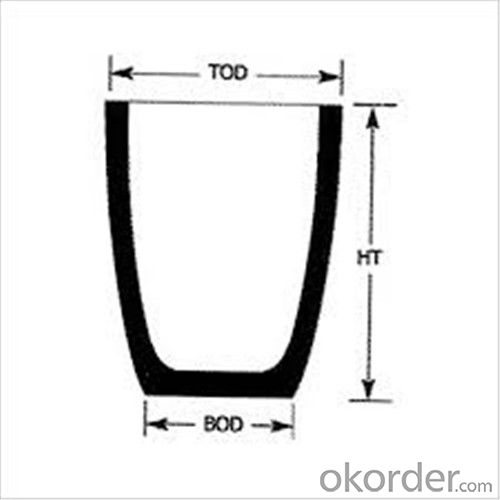

Graphite crucible can withstand the high temperature, and has good resistance to chemical erosions and thermal shock. Especially graphite crucible is ideal for the melting of aluminum, copper and etc.
Bulk Density | g/cc | 1.70-1.88 |
Specific Resistance | μΩ.m | 6.0-15.0 |
Compressive Strength | MPa | 30-80 |
Bending Strength | MPa | 20-45 |
Shore hardness | 30-70 | |
C.T.E.(100-600°C) | x10-6 /°C | 2.5-5.5 |
Ash | % | 0.01-0.2 |
Maximum Grain Size | mm | 0.044-0 |
Other Products

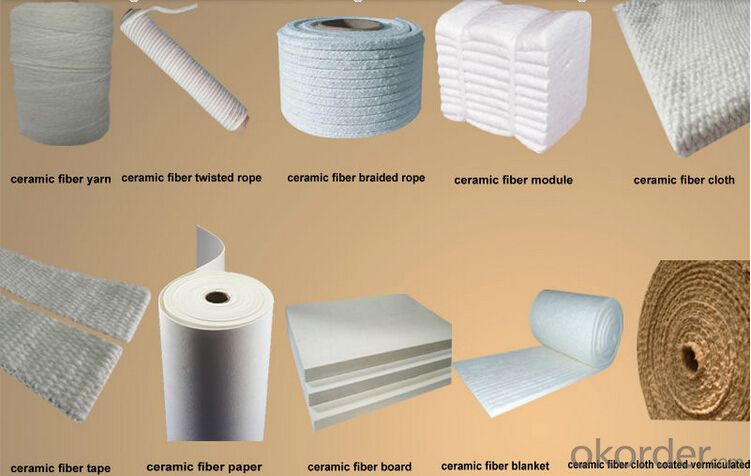
FAQ
1.What's your MOQ?
We will indicate the MOQ for each item in the quotation list. We accept the sample and trail order.
2.Can I negotiate the Prices?
Sure, we may consider discounts for bulk order of products.
3.How long will it take to complete my order?
For the stock items, we can arrange the shippment within 2~3days after received your payment. For the customized items, we will indicate the delivery time in the quotation list.
4.Can you give warranty of your products?
Yes, we extend a 100% satifisfaction guarantee on all items. Please feel free to provide timely feedback if you're not satisfied with N&D's Quality and Service. For the overseas orders, if there is a quality problem, please kindly to provide the picturers to show the problem by e-mail. We will provide the replacements to you at our cost according to actual conditions.
5.Can I visit you?
Sure. If you're a volume buyer and would like to visit our in-house products and production line, please contact us to make an appointment.
- Q:Can graphite crucibles be used for heat treatment processes?
- Graphite crucibles are capable of being utilized in heat treatment procedures. Graphite possesses a high melting point and exceptional thermal conductivity, rendering it an optimal material for applications necessitating elevated temperatures and efficient heat transfer. Heat treatment processes entail the elevation of materials to specific temperatures in order to modify their physical or chemical properties. Graphite crucibles can endure these elevated temperatures without undergoing melting or deformation, guaranteeing the stability and integrity of the heat treatment procedure. Moreover, graphite's minimal reactivity with most substances renders it suitable for a broad range of heat treatment applications, encompassing annealing, tempering, quenching, and carburizing. In general, graphite crucibles prove to be a favored choice for heat treatment processes due to their resistance to high temperatures, thermal conductivity, and chemical inertness.
- Q:Can a graphite crucible be used for melting steel?
- No, a graphite crucible cannot be used for melting steel. Graphite has a relatively low melting point (around 3,600 degrees Fahrenheit or 2,000 degrees Celsius), while steel requires much higher temperatures to melt (around 2,500 degrees Fahrenheit or 1,370 degrees Celsius). Thus, using a graphite crucible would result in the crucible itself melting before achieving the desired temperature to melt the steel. For melting steel, a crucible made of materials with higher melting points, such as clay-graphite or silicon carbide, would be more suitable.
- Q:What are the different methods of removing impurities from a graphite crucible?
- There are several methods for removing impurities from a graphite crucible. One common method is to heat the crucible to a high temperature, which causes the impurities to burn off or vaporize. Another method involves soaking the crucible in a chemical solution that can dissolve the impurities. Ultrasonic cleaning is also an effective method, where high-frequency sound waves create vibrations that help dislodge the impurities. Additionally, physical methods like scrubbing or scraping can be used to remove any remaining impurities from the crucible's surface.
- Q:How do you determine the appropriate crucible weight for a specific application?
- Determining the appropriate crucible weight for a specific application involves considering several factors. Firstly, you need to identify the material or substance that will be placed in the crucible. Different materials have varying densities and melting points, which will affect the weight of the crucible required to contain them. Next, you should consider the desired capacity or volume of the material to be melted or heated in the crucible. This will dictate the size of the crucible needed, and consequently, its weight. It is important to choose a crucible that can comfortably accommodate the desired amount of material without overflow or spillage. Additionally, the heating method and equipment being used should be taken into consideration. Different heating sources, such as open flame or electric furnaces, may exert different amounts of stress on the crucible. It is crucial to select a crucible that can withstand the heat and maintain its structural integrity throughout the application. Furthermore, the intended use of the crucible should be considered. Some applications may require the crucible to be subjected to extreme temperatures or aggressive chemicals, which may necessitate the use of a more durable and heavy-duty crucible. Lastly, it is advisable to consult the manufacturer's guidelines or technical specifications for the specific crucible material and model being used. Manufacturers often provide recommendations for the appropriate crucible weight based on their expertise and testing. Overall, determining the appropriate crucible weight for a specific application involves considering the material to be used, desired capacity, heating method, intended use, and consulting manufacturer guidelines. By carefully evaluating these factors, you can select a crucible that meets the requirements of your application and ensures safe and efficient performance.
- Q:What are the different methods of monitoring the melting process in a graphite crucible?
- There are several methods available for monitoring the melting process in a graphite crucible. These methods can provide valuable information about the temperature, consistency, and progress of the melting process. 1. Visual Inspection: One of the simplest methods is to visually inspect the melting process. This can be done by observing the color, consistency, and movement of the materials being melted. For example, if the materials are turning into a liquid state and flowing smoothly, it indicates that the melting process is progressing as expected. 2. Thermocouples: Thermocouples are widely used for temperature measurement in various industrial processes, including melting in graphite crucibles. These devices consist of two different metals joined together at one end. By measuring the voltage difference between the two ends, the temperature can be determined. Thermocouples can be inserted into the crucible or placed near it to monitor the temperature accurately. 3. Infrared Pyrometers: Infrared pyrometers are non-contact temperature measurement devices that use infrared radiation to determine the temperature of an object. They can be used to monitor the temperature of the graphite crucible during the melting process without physically touching it. Infrared pyrometers provide quick and accurate temperature readings. 4. Optical Emission Spectroscopy (OES): OES is a technique that analyzes the light emitted by the materials being melted to determine their composition and temperature. By analyzing the spectral lines and intensities of the emitted light, OES can provide valuable information about the melting process, including temperature and the presence of impurities or alloying elements. 5. Pressure Measurement: Monitoring the pressure inside the graphite crucible can also be an indicator of the melting process. As the materials melt and vaporize, the pressure inside the crucible may increase. Pressure sensors can be employed to measure the pressure changes during the melting process, providing insight into the progress of the melting and the behavior of the materials. These methods can be used individually or in combination to monitor the melting process in a graphite crucible. By employing one or more of these techniques, operators can ensure that the melting process is proceeding as intended and make any necessary adjustments or interventions to maintain optimal conditions.
- Q:Can graphite crucibles be used for both melting and casting?
- Yes, graphite crucibles can be used for both melting and casting. Graphite crucibles have a high melting point and excellent thermal conductivity, making them suitable for melting metals and alloys. Additionally, their smooth surface and durability allow for easy pouring and casting of the molten material.
- Q:Can a graphite crucible be used for gold melting?
- Yes, a graphite crucible can be used for gold melting. Graphite crucibles are commonly used in various industries, including jewelry making and metal casting, due to their high melting point and excellent thermal conductivity. Graphite is highly resistant to high temperatures, making it suitable for melting gold, which has a relatively low melting point of around 1064 degrees Celsius (1947 degrees Fahrenheit). Moreover, graphite crucibles do not react with molten gold, ensuring that the purity of the gold remains intact during the melting process.
- Q:Melting the iron in the graphite crucible. Does the graphite in the crucible turn into carbon and it melts into the steel?
- Graphite is a very pure substance, and graphite is a transition crystal. The carbon atoms in each layer of graphite are bonded by non-polar covalent bonds, and the molecular layers of graphite are joined by intermolecular forces. The melting point of the graphite crucible is 3652 to 3697 degrees (sublimation), so the graphite crucible is high temperature resistant.
- Q:Can a graphite crucible be used for melting berkelium?
- No, a graphite crucible cannot be used for melting berkelium. Graphite crucibles are commonly used for melting metals with lower melting points, such as iron, aluminum, or copper. However, berkelium is a highly radioactive and rare element with a melting point of around 986 degrees Celsius. To handle and melt berkelium, specialized equipment and materials that can withstand high temperatures and the corrosive nature of the element are required. These materials are typically made from refractory metals like tungsten or tantalum, which have higher melting points and better resistance to corrosion. Therefore, it is not recommended to use a graphite crucible for melting berkelium due to its unsuitability for the extreme conditions associated with this element.
- Q:Is the silicon carbide crucible good for use? What's the difference between an ordinary graphite crucible and a graphite crucible?
- The crucible can be placed on the iron tripod with either positive or oblique directions, and can be placed on the basis of the requirements of the experiment. When the crucible is heated, it cannot be immediately placed on a cold metal table to prevent it from breaking due to rapid cooling. It should not be placed on the wooden table immediately so as not to spoil the table or cause fire. The correct method is to cool the metal on the tripod or to let it cool slowly on the asbestos net. For crucible purposes, see the crucible tongs. The relevant information from the supply of silicon carbide crucible dachengxian Tianjin high silicon carbide crucible crucible factory released using the latest international technology of isostatic pressing method and strict quality assurance inspection system, using advanced refractory raw materials, high-tech formula developed a new generation of high-quality silicon carbide crucible, this product has a large volume density, high temperature resistant, fast heat, acid and alkali resistance, high temperature strength, oxidation resistance and high service life is 3 times that of the clay graphite crucible.
1. Manufacturer Overview |
|
|---|---|
| Location | |
| Year Established | |
| Annual Output Value | |
| Main Markets | |
| Company Certifications | |
2. Manufacturer Certificates |
|
|---|---|
| a) Certification Name | |
| Range | |
| Reference | |
| Validity Period | |
3. Manufacturer Capability |
|
|---|---|
| a)Trade Capacity | |
| Nearest Port | |
| Export Percentage | |
| No.of Employees in Trade Department | |
| Language Spoken: | |
| b)Factory Information | |
| Factory Size: | |
| No. of Production Lines | |
| Contract Manufacturing | |
| Product Price Range | |
Send your message to us
SiC Crucibles For Melting Aluminium And Copper, Brass, SIC Graphite Crucible
- Loading Port:
- Shanghai
- Payment Terms:
- TT OR LC
- Min Order Qty:
- 1 pc
- Supply Capability:
- 1000 pc/month
OKorder Service Pledge
OKorder Financial Service
Similar products
New products
Hot products
Related keywords
